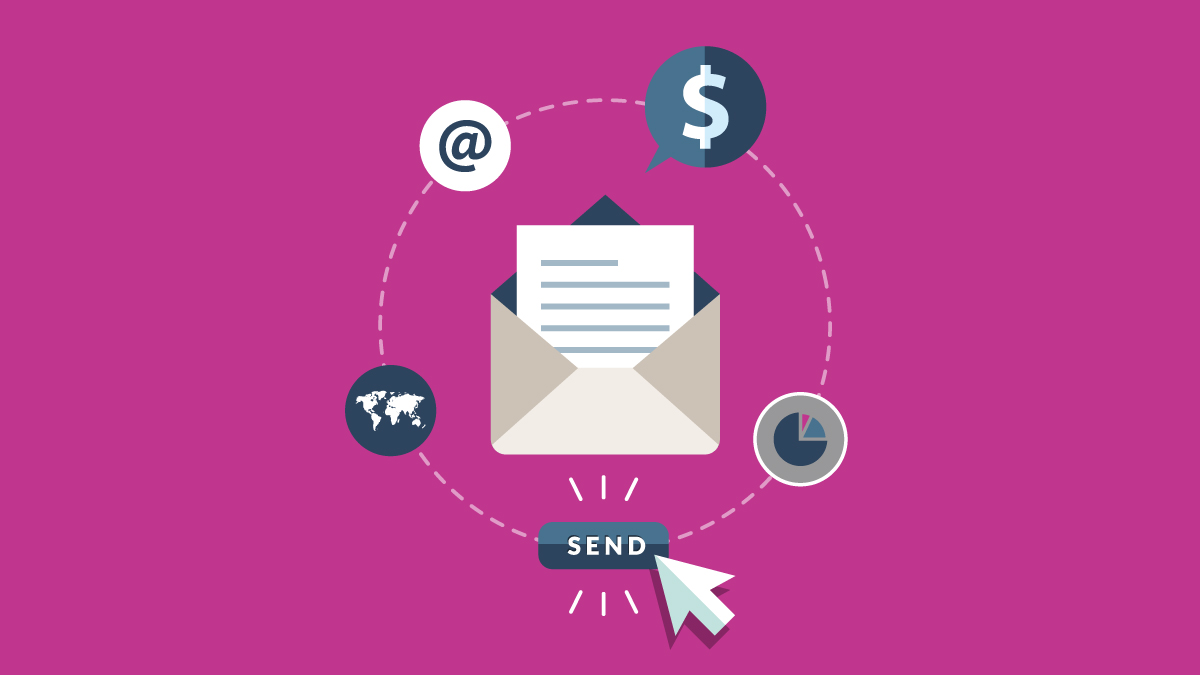Why Email Marketing is Crucial to Your Business
Email – we all use it. Whether you’re keeping in touch with a high school friend in another state, thanking your grandma for that birthday money she sent you (yes, my grandma uses and loves email), checking out what’s on sale at your favorite clothing store, or sending a promotional message for your brand, email is a pretty integral part of our everyday lives. According to /ExactTarget’s 2014 State of Marketing study, 58% of marketers plan to increase spending on email marketing in 2014. It doesn’t sound like email is going anywhere anytime soon, so let’s dig a bit deeper into the history and future of email marketing.
History of Email Marketing
So where did it all begin? In 1971, /Ray Tomlinson implemented an email system on /ARPAnet (Advanced Research Projects Agency), which made it possible to send messages to users on two different computers. He achieved this by using the @ symbol (which may look familiar!) to differentiate each user from their machine. Seven years later, the first mass email was sent in /1978 by Gary Thuerk, which was a message that promoted DEC (Digital Equipment Corporation) machines to 400 users via ARPAnet. It wasn’t until 1991 with the introduction of the internet to the masses that email would be widely available to marketers and consumers. In 1998, the /Data Protection Act was updated in order to protect consumers by implementing the use of an opt-out link in all marketing communications. Email has continued to boom since then, with /95% of online consumers using email today.
The Mobile Inbox

Mobile email has been on the rise since 2012, with over 50% of email users now opening and viewing their email on mobile. It’s extremely important for your brand, or your client’s brand, to design emails to be viewed on more than just desktop machines. If your email marketing platform doesn’t support responsive design (which we’ll get into a bit more later), or if your HTML skills aren’t that extensive, you can still design your email campaigns with mobile in mind.
Email Tips
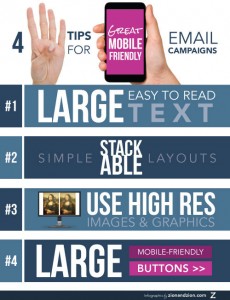
Here are four quick, easy changes you can make to your email campaigns to ensure they are mobile friendly:
1) Use large, easy to read text.
2) Include large, hi-res images.
3) Keep layouts simple – think single column for easy scrolling.
4) Use large, mobile-friendly buttons and calls-to-action – remember: your finger is much larger than a mouse pointer!
Responsive Email Design
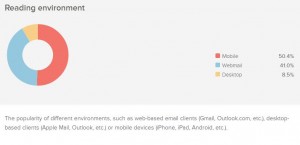
Similar to responsive web design, your email campaign HTML can be written to adapt to your user’s device – whether it be desktop, mobile, or tablet. Although responsive email design does not work across all email clients, takes longer to code and test, and is harder to learn, it’s important to be aware of, as the future of email is moving toward responsive. Using programs like /Litmus or /Email On Acid allows you to analyze your audience and see how many of them are using desktop, mobile, or tablet to view your email campaigns. Knowing this information is important, as you want to be sure you’re designing your email campaigns with your core audience in mind. If your audience skews heavily toward mobile and tablet use, taking the leap and investing in responsive design may be the right thing for your brand and your clients.
Email Campaign Testing
There are a variety of tests you can perform on your audience in order to increase /open rates, /click through rates, and overall engagement with your email campaigns. Let’s look at three of the most common, easy to implement email campaign tests.
A/B Subject Line Testing
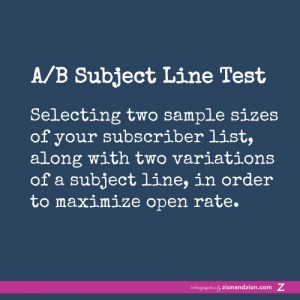
The first and easiest test, is A/B subject line testing. Most email marketing platforms have this feature built-in to your dashboard, so they do the hard work for you by splitting your audience into two sample groups, sending a subject line variation to each over a set time span, and then automatically sending the winner based on highest open rate. There are a variety of variables you can test in your subject line, including but not limited to:
- Using special characters
- Capitalization
- Personalization
- Exclamation points
- A question
- Sense of urgency
The world of subject line testing is your oyster!
Time of Day Testing
Not all email marketing platforms have this testing function built-in, but it’s fairly easy to do manually by splitting your entire list into two or more groups. After you create your groups, send your campaign with the same subject line to each group, but at different times of the day – for example, 8am, 12pm, and 5pm, to see if your subscribers are more likely to open your email in the morning, afternoon or evening. You’ll want to run these tests often, as the results from just one test shouldn’t dictate your send time.
Creative Testing
Yet another feature only available in certain email marketing platforms, but a test you can also do manually, is creative testing. Whether it’s changing the copy on a sale headline or blog post title within your email, or using two different images to promote one sale item, creative testing can help narrow down the types of messaging and imagery your audience best responds to.
Measuring Email Success
Analyzing your email campaign data is important for two reasons. One, you want to measure your success, and two, you want to improve upon your previous campaigns. Diving deeper into your analytics and looking at open rate, overall click-through rate, individual link click-through rate, and Google Analytics can help you set benchmarks and improve your results.
Open Rate
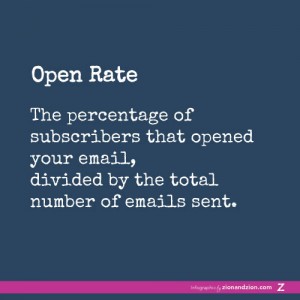
Many marketers focus very heavily on trying to achieve good email open rates to be above and beyond their industry standard. The reality is, benchmarks are BS (there, I said it). Your business is just that: your business. Comparing your customers to someone else’s customers is like comparing apples to oranges. The best thing you can do is create benchmarks specific to your business in order to assess and improve upon them.
Overall CTR
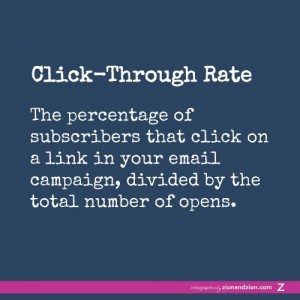
Similar to open rate, you want to make sure that you’re setting your own benchmarks for your overall click-through rate of your email campaigns. Although it’s important to analyze and improve upon your overall CTR, it’s even more important to look deeper into where your subscribers are clicking within your email campaigns (we’ll talk about this next) because it gives you greater insight into what changes and improvements you can make to your overall email design.
Individual Link CTR
It’s important to analyze the click-through rate on the individual links in your email campaigns. Are your subscribers clicking where you designed for them to click? Are there certain types of content that get clicked on more than other types of content? Is there a particular link that just never gets clicked that you can get rid of because it takes up precious real estate in your email design? The analytics associated with these types of questions will help you make smarter decisions relating to your email design and content, which in the end will give your subscribers an overall better experience with your email campaigns, and your brand.
Google Analytics
If you have Google Analytics tracking code installed on your website (and you should!), you can easily tag your email campaigns and get even deeper insight into where your email subscribers are clicking once they land on your site. By using the Google Campaigns URL Builder, you can simply plug in the information necessary for tracking and tag all of the links in your email HTML with Google’s URL tracking. There is an endless amount of data you can analyze here, so it’s important to think about what kind of data is most relevant and crucial to your brand. You should use this data to make changes to your site that make the user experience better for your customers. For example, if you’re finding that the majority of your email subscribers are clicking through to a product page, but are dropping off once they get to the checkout and aren’t converting, it’s possible there’s an issue with your site that is preventing them from having a smooth purchase experience.
The Future of Email Marketing
Email marketing will only get more sophisticated as time goes on. Creating a strong email marketing strategy with the consumer in mind is key. By subscribing to your emails, consumers are inviting you into their inbox. It’s important that you draw them in from your very first email communication in order to gain their trust and loyalty.
